The Definitive Guide To Google My Business
This step-by-step guide will help you understand Google My Business inside and out so that you can improve your Google Map rankings, communicate with customers, control your online presence, and generate more leads.
What we’ll be covering
Introduction
Set up a GMB Listing That is Optimized From Day One
The most important part
Top GMB tools to help you succeed
Expert advice from around the world
Download this guide for quick reference and roll out.
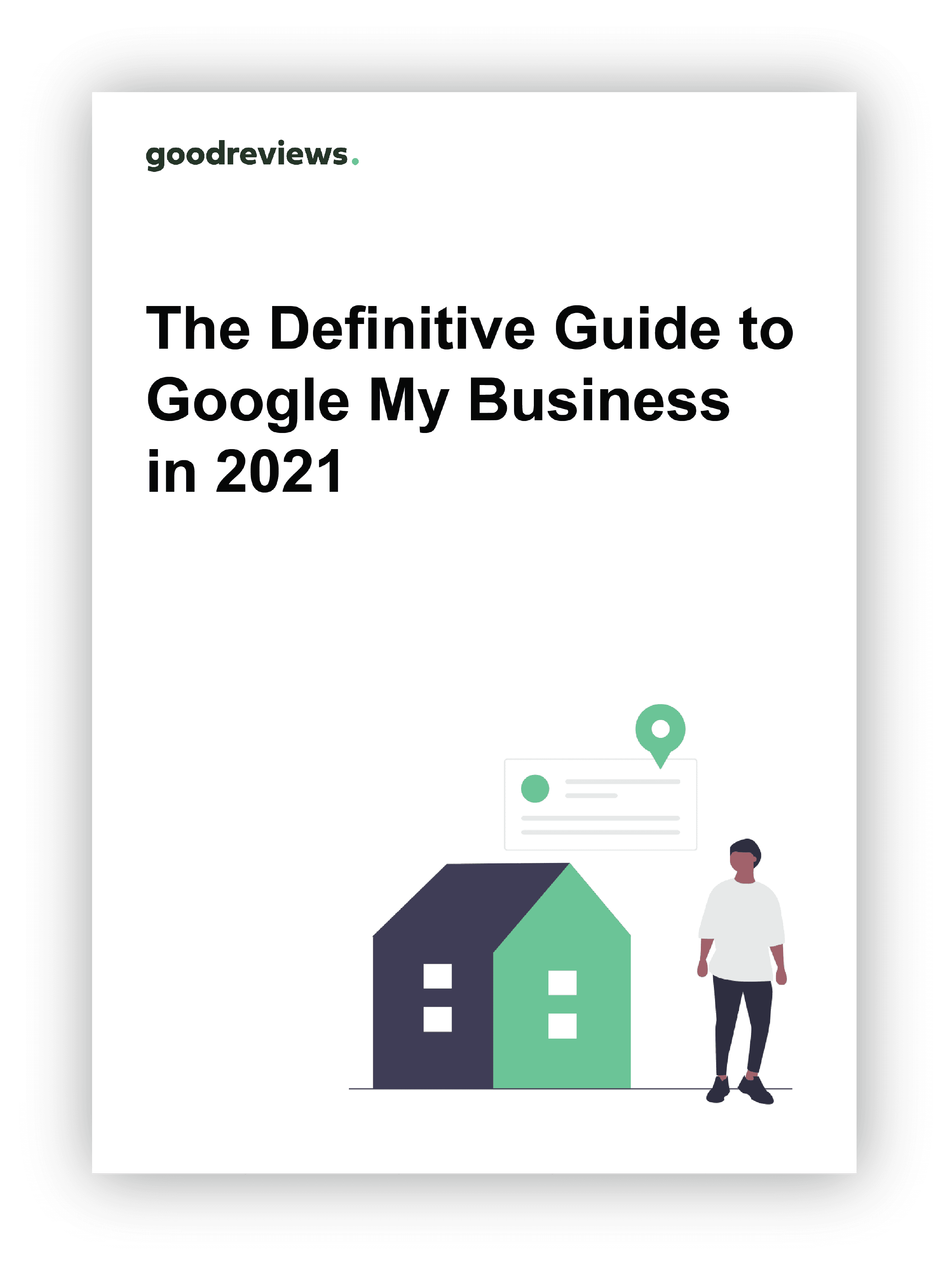
Introduction to Google My Business
Google My Business(GMB) is a relatively new marketing tool that gives business owners more control over the way their company appears in search results.
It is no secret, GMB has solidified its place as the dominant entry point for local search. Recent studies have found that 74% of consumers conduct local searches at least once a week. Of those searches, 54% said they would visit the business in person, either right away or the same day.
That’s crazy. One in two are ready to become customers.
So for business owners having the power to manage what comes up about them in search results is a big, big deal. Businesses can catch customers’ attention in the search results, manage their own reputation, and reap the rewards of cleaner, bolder web presence.
This step-by-step guide will help you understand Google My Business inside and out so that you can improve your Google Map rankings, engage with customers, control your online presence, and generate more leads.
We will cover;
- What is Google My Business & why it matters in 2021
- How to setup an optimized profile from day one
- What ongoing optimisations are required
- How to collect and respond to reviews
- Tools that you can use to stay on top of your game
- Expert advice from around the world
What is Google My Business? (the official answer)
Google My Business (GMB) is a free tool created by Google to help business owners manage how they appear in Google search results and on Google Maps.
Why is GMB important?
I’m going to hold on the technical mumbo jumbo for a second and instead do some back of the envelope math…
The search term “Yoga Studio Near Me” gets 60,500 searches a month in New York City.
Of those searches, 17.3% go to the first business listed in the local pack(picture). Meaning, whoever is in position 1 gets 10,466.5 visits to their website.
The average cost of a drop-in yoga class in NYC is $16 and let’s say a conservative 5% sign up for a class.
That’s $8,373.2 a MONTH in revenue generated from your GMB Profile. (not including Life Time Value or any repeat purchases). Realistically the real revenue numbers would be far larger.
There is the business answer to why GMB is so very important. It is a core element of local SEO and when optimized lets you reap the benefits of more leads and more revenue.
The best part? The anatomy of a highly-effective GMB profile isn’t rocket science. Every business owner can implement simple changes and realize remarkable results.
How important is GMB in 2021?
For those of you who remember, we used to pick up a big yellow book and comb through the pages to find local businesses. Now, anytime, anywhere, we can open Google and get 322,000,000 results in 0.77 seconds. And that’s what we do, every day and every year we do it more. Google Trends data shows the dramatic increase in “near me” search queries providing businesses with an opportunity to target potential customers seeking a local business.

The local 3 pack continues to receive a dominant proportion of clicks, currently making up 32.3% of all clicks on the Search Engines Results Page (SERP). There is no denying the impact of that traffic to your business and the revenue it can generate as a channel. Businesses can no longer forgo focusing time and attention on their listing.
Brightlocal analyzed click-through rates of the Search Engine Results Page(SERP) and found:;
- Organic position 1 27.4%
- Local Pack position 1 17.3%
- Local Pack position 2 12%
- PPC Top position 1 10.5%
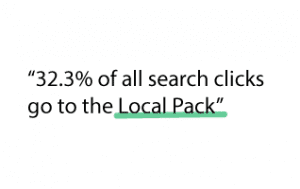
Here are some additional stats if you’re not yet convinced:
- 46% of all Google searches are local
- 64% of local customers use search engines and directories as their main way to find local businesses
- 50% of local mobile searchers look for business information (like a company’s address or phone number)
- A whopping 78% of local mobile searches result in an offline purchase
Sources: Searchengineland.com and Business2community.com
Google continues to make changes to GMB
Google’s intentions remain strong as they continue to invest time, money and energy into their GMB product. As you can see below, the velocity of changes over time has been consistently accelerating.
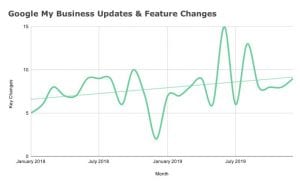
Sources: https://www.sterlingsky.ca/google-local-changes/
Why Google’s creation should make you stop and think
Google’s core business model has always been the monetization of attention. They’ve mastered both the dissemination and distribution of business information. When they wield their gauntlet to monetize, many companies who have historically relied on them – and paid them – to get visitors through the door perish.
At the beginning of the last decade, websites like Kelkoo, Pricerunner, Shopping.com and Dealtime dominated online shopping. Now, they barely make an impression in search results.
What happened to them? Google Shopping.
And now with Google My Business, people don’t need to visit your website anymore to:
- Book an appointment
- Get a quote
- Call you
- Message you
- Ask questions
- Post reviews
- Find your offers and pricing
- Find directions
…all those things people go to your website for.
Think about that for a second… and where this could lead.
Contest Google at your peril
That last section might have got you referencing some 1984 quotes or debating Google’s ethics of keeping their own traffic.
But ultimately we have two choices.
We can complain about how Google is evil.
Or, we can delve into this new digital landscape, understand it and systemize our efforts to increase our digital reach and ultimately our baseline revenue.
We haven’t mentioned something very, very significant
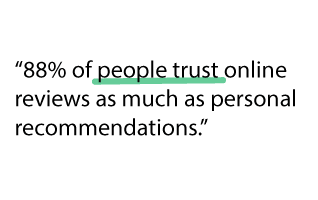
Every year, without a doubt, potential customers rely more and more on reviews.
Let’s face it, nobody likes the guy at the party gloating about how awesome they are.
We don’t like it online either…
We like hearing from others, which is why in 2021 reviews are one of the most important parts of not only your GMB but your collective business efforts.
In fact one of the most important parts of buying psychology is…
Social proof. (just ask Cialdini)
Shawn Joshi, a veteran digital marketer, examined the difference in GMB traffic vs. Organic traffic. Whilst he didn’t reveal the client he did say “The numbers are significant(analyzing millions in revenue).”
So what was concluded? Revenue per lead (search traffic): $197 Revenue per lead (Google My Business traffic): $679
Leads from Google My Business are worth 245% more than regular search traffic – wow. It is also important to note here that Organic Traffic is usually the highest converting digital channel.
Imagine if you could up lead quality like this on your website? Well, you can with the Goodreviews tool that pulls in your Google My Business reviews and allows potential customers to browse your brand credibility. (oh, and it automates your review collection). Click below to start a 30-day free trial and see the results for yourself.
For those of you who aren’t convinced
Stop reading here.
For those of you who are, we know a few things.
The first, our customers are using Google and we cannot turn our back on the opportunity.
The second, Google favours itself, as we’ve seen and will continue to see. We need to understand how we can evolve our digital efforts alongside the incumbent.
The third, we’re ready to do the work.
Set up a Google My Business Listing That is Optimized From Day On
Step one: Visit the official home page
Navigate to the official business page. Found here. https://www.google.com/business/
Click the Blue Manage Now button.

If you’re not already signed into Gmail, it will ask you to sign in.
Be sure you are signed into the Gmail account you want to be associated with your Google business listing.
Pro Tip: Use the email you use for other Google Properties like Search Console or Google Analytics.
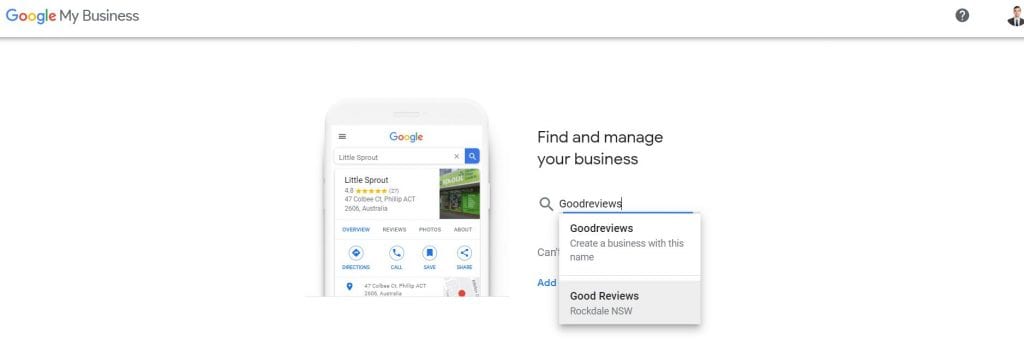
Then click next.
Step Two: Enter your business name (don’t keyword stuff)
As with most aspects of life, doing the right thing is the right thing to do. Attempting to deceive search engines with keyword stuffing shortcuts isn’t going to work – following legitimate SEO best practices will.
With that said, Google in many cases fails at creating an equal playing field and many take advantage of that inequality for short-term gain.
In the 2018 version of Moz’s Local Search Ranking Factors Survey, their survey placed having your Product/Service Keyword in your GMB Business Title as the number #4 most important ranking factor.
This saw the extreme rise of adding keywords to your local listing alongside a location call out.
So instead of a business name like Mary’s Firm SEOs would change titles to Mary’s Divorce Lawyers London.
Here’s an interesting example…
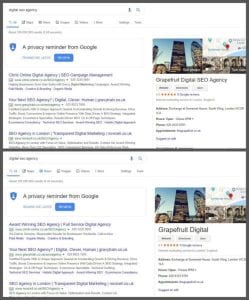
The top screenshot shows how an agency was able to gain a knowledge panel for the non-brand search term “digital seo agency” by putting “SEO Agency” in its GMB profile. Even after the spammy name was reported, the knowledge panel remained, as shown in the second screenshot.
Now you’re probably thinking to yourself…
Well.. it works! Why wouldn’t I do it?
Well, this screenshot was from Q2 of 2019, in Q4, Google released an algorithm update that punished those with a location in their business name(especially if it was located at the end). However, different SEO Experts between 2019/2020 have noticed rankings bouncing back.
Was does this mean? What should I do?
Google is in constant flux, sometimes there are clear cut definitions and sometimes there are not. At the time of writing this, the jury is still out on how businesses should proceed.
With that said…
Here’s what you should know. Google’s policy states:
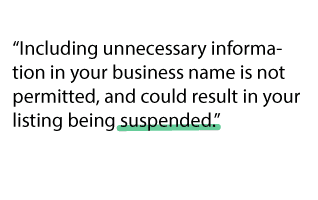
Sterling Sky’s case study on keyword stuffing found that keyword stuffing led to a suspension from Google in 40% of cases! Those are pretty high odds to reap the benefits of the rank boost keyword stuffing provides.
As always, my opinion is to do the right thing and continue to do it over time. You might forgo some short-term wins but ultimately you will come out on top.
So here for your business name represent your business as it’s consistently recognized in the real world across signage, stationery, and other branding.
Step Three: Select business category (proper GMB Category Associations)
The same Moz survey found that GMB Category Associations was #3 most important ranking factor.
As with the business name be specific about what and who you are.
To use the same example of a lawyer just look at how many categories there are. Pick the one that BEST represents you.
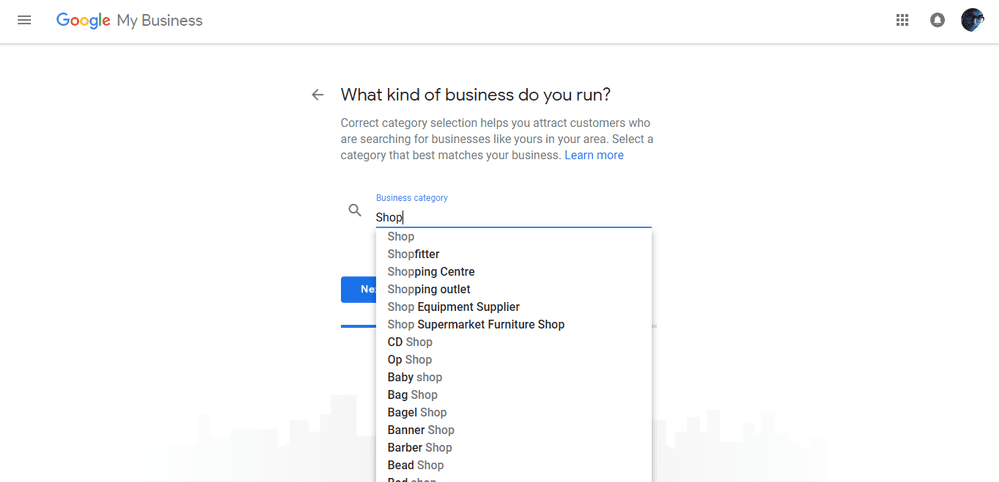
You might be saying to yourself here, we offer multiple services?
Well, I would say out of those services does 1 make up 80% of revenue? If so, go with that – that really is WHO you are right now. All in all, you can change it at any time if you need to or your revenue-driving activity changes. We will also be adding subcategories.
Step four: Setting the Address of Your Business
The Moz study found that the two most important factors to your ranking are where the searcher is located, aka. proximity (#1) to the physical address of your business (#2).
Google wants to serve you the most relevant business that is close to you, so that next time you need to search, you go to Google. Imagine if every time you searched for something near you, it was over an hour away. Would you still use their service? Probably not. Would they lose customers? Most definitely.
We will get into optimizing so that you are more likely to appear within proximity, but the point here is not to fool yourself by thinking you will dominate your entire city.
Here you have 3 options, do you:
- Let customers come to you
- You go to your customers
- Or do you do both.
Fill as required.
Step five: Let’s get verified
Depending on what kind of business listing you’re attempting to create (or manage) you will have different options available to you. With that said, 90% of businesses will need to wait for a postcard.
All options:
- Verify by mail (postcard)
- Verify by phone
- Verify by email
- Instant verification
- Bulk verification
Once your postcard arrives you’ll need to sign back into google.com/my business, click Verify Location from the menu or the Verify Now button if it’s available, then enter the 5 digit code from your postcard.
Step six: Set up the bare minimum(s)
Once you have an officially verified listing, it’s time to optimize your Google My Business.
Enter the following (we will explain in further detail the other sections to fill):
- operational hours
- special hours (public holidays etc)
- business phone number • profile short name
- appointment link
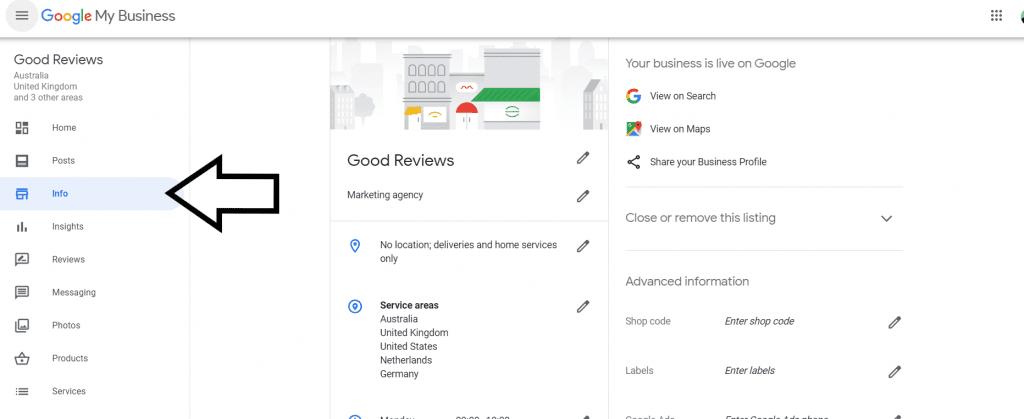
Step seven: Add optimized photos
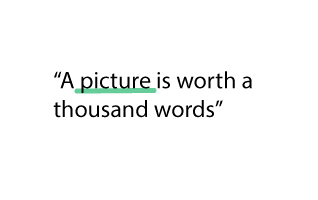
Don’t take this for granted, 60% of consumers say local search results with good images capture their attention and push them towards a decision.
Google advises businesses to upload several different types of images;
- At least three strong exterior photos, taken at different times of the day and showing the approach to the business from common angles
- A minimum of three interior photos
- Product photos for the most popular products and services you sell
- One image of any common areas your business may have, such as the reception
- A minimum of three management and team photos
- For bars, restaurants and cafes, images of the most popular food and drinks
- For hotels, images of guest rooms should be uploaded
Image requirements
Format: JPG or PNG
Size: Between 10 KB and 5 MB
Minimum Resolution: 720px × 720px
Quality: The photo should be in focus and well lit, and have no significant alterations or excessive use of filters. In other words, the image should represent reality.
What does Google say?

Geotag your photos
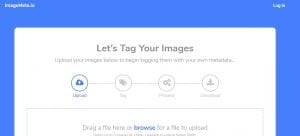
Techy explanation: Geotagging is the process of adding geographical information to various media in the form of metadata.
General explanation: Add some information that tells Google where the photo was taken.
Navigate to https://imagemeta.io/ follow the steps.
Tip: You should have 10 or so geotagged photos within your profile.
Step eight: Add videos
Across the digital landscape, video content continues its rise to prominence. Its use within GMB is important.
Don’t just add random videos. Ensure your videos aren’t shaky and aren’t shot in portrait mode.
Ask yourself, “If my competitor uploaded a video like this, would I make fun of them or envy them?”
As I’ve said in this guide countless times now Google will always punish companies who aren’t truly representing themselves. Google can and will remove videos if the primary subject of the content is not related to the location. So, don’t use stock video.
Video requirements
Max File Size: 100 MB
Max Video Duration: 30 Seconds Video
Min Resolution: 720p
Content ideas to get you started:
- Video tour of your business
- Video of staff (either doing work or giving an introduction of themselves)
- Video of owner explaining why they made the business (mission/vision etc)
- Interviewing customer
Step nine: Write an optimized & compelling business description
You can add a 750-character description to your GMB profile. This text should describe your business in an engaging, authentic manner and shouldn’t reference things like sales or promotions.
Writing a comprehensive and compelling business description takes work. I recommend that you write out several versions before selecting which one you want to go with. Be sure to read all the business description guidelines (shown below) so you know what you can (and can’t) include in your Google My Business Business Description.
Tips for writing
- Tell the viewer what makes your business different
- Why should they shop with you & not someone else
- Don’t spam
- Don’t keyword stuff
- Don’t put promo’s in and sound gimmicky
- Don’t use ALL CAPS
Step ten: Add additional categories
Earlier in the guide, we selected our primary category. While the primary category is the most important choice, secondary categories are still important to ranking and relevance. There are over 3000 GMB categories as of 2020 (3942 to be exact). Google allows you to select up to 10 categories for your business. You can view a complete list here.
When you select a category, you’ll have the best results if you follow these three rules of thumb:
- Be as specific as possible when choosing your Google My Business category – The more specific you are, the fewer businesses you’ll be competing against for customers.
- Add the least number of Google My Business categories possible to describe your core business – The more categories you have, the weaker each individual category gets in a potential customer’s search for businesses that do what you do
- Describe your business… not your services or amenities – If you are adding a new restaurant to Google My Business and that restaurant has a bar, you should not add “Bar” as a category because that does not describe your business, it describes your amenities.
Step eleven: Add product collections
Product Collections are for small- and medium-sized individual businesses. If you sell products, use this as an opportunity to give Google further information about who you are and what you sell. Showcase your KEY products and drive customer interactions.
Navigate to products tab on the left and click get started. The process is straight forward and can be viewed in full here.

Step twelve: Set up tracking – the right way
f you measure the wrong thing, you set the wrong targets and if you aim at the wrong target, you arrive in the wrong place.
Tracking is one of the most important parts to get right from the get-go.
We need to set-up UTM tags.
Why?
Without UTM tags, a page could be receiving organic traffic from two places and you wouldn’t have any idea which was the biggest driver:
- Standard organic results.
- Google My Business profiles (knowledge graphs, local map packs, Google Maps)
Sure, in the Google My Business backend there are some reports, showing the number of impressions (how often my listing appeared), clicks on the phone number, get directions button or website button and some other data:
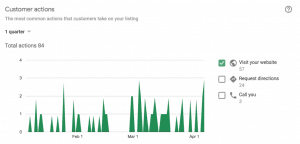
In Google Analytics, if we use UTM tags we can uncover things like: How many pages did they view or did they make a revenue-driving action.
Go to URL Builder and enter your relevant naming conventions. If you haven’t already set up a complete UTM naming strategy I would recommend this. For GMB I would recommend the following:
- Source = Google
- Medium = organic
- Campaign = mybusiness
- Content(only if multiple locations). If you have multiple locations use this section to add an identifier like a postcode. By doing so, you will be able to break your data out per location and dive deeper into per store analytics.
https://www.yourwebsite.com/?utm_source=google&utm_ medium=organic&utm_campaign=mybusiness
Once you’re all set with creating your new UTM tracking URL, you need to add it to your listing. To do this, simply go to your account dashboard and select either info or edit. This will bring up a new screen with your company information.
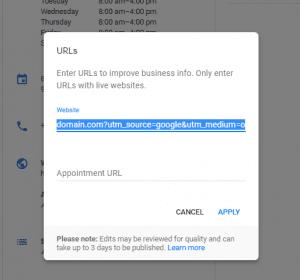
Scroll down to find the existing URL and replace it with the new UTM tracking URL.
Once you add the new URL to your listing, you can refresh the page and it should be live.
How to view in Google Analytics
Now all of the hard work is complete, we’re able to tap into our Google Analytics account and garner deeper insights. Login to your Google Analytics account and select the appropriate profile. Then navigate to: Acquisition > Campaigns > All Campaigns. You will be able to see how those coming from your GMB interact with your website and importantly their onsite conversion rate. We’ve seen conversion rates of 16% through GMB but most hover at 6%.
Step thirteen: Download the GMB App
The Google My Business app for iOS and Android is a great tool for monitoring the latest activity related to your listing.
Tapping the Notifications tab from the Menu gives you an overview of your latest reviews, insights on your most recent posts, bookings, payments, and product updates.
Use the Google My Business app to:
- Update your business hours, location, contact information, and description • Post statuses and pictures
- View search insights
- Respond to reviews
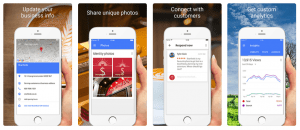
Step fourteen: Familiarize yourself with GMB Insights
Delve into and make use of Google My Business Insights, to learn things like:
- How many people visit your website
- How many people searched for driving directions
- How many people called you
- How many people viewed photos of your business
To benchmark, your business’s GMB performance against others in your industry, take a look at this Google My Business Insights Study.
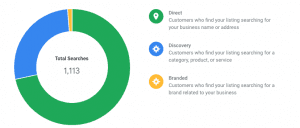
We’ve covered our basis, now what do do?
Arguably the most important part: Reviews
Why do sitcoms have laugh tracks? Why do waiters salt their tip jars? Why do we want to try a restaurant when we see it at full capacity?
The answer, Social Proof. A psychological and social phenomenon within consumer behaviour where we look at others in order to take action.
Reviews are the lifeblood of small businesses. It is one of the most influential factors when it comes to people making a buying decision. In fact, when people add our google review tool to their website we’ve seen conversion uplifts from 5-25%.
But reviews don’t only affect your onsite conversion rate…
According to Moz, review factors (total amount, review velocity, review diversity) makeup of why 15.44% of all local search ranking factors – crazy right.
Another study by Bright Local examined the average number of google reviews by local ranking position. They found the following…
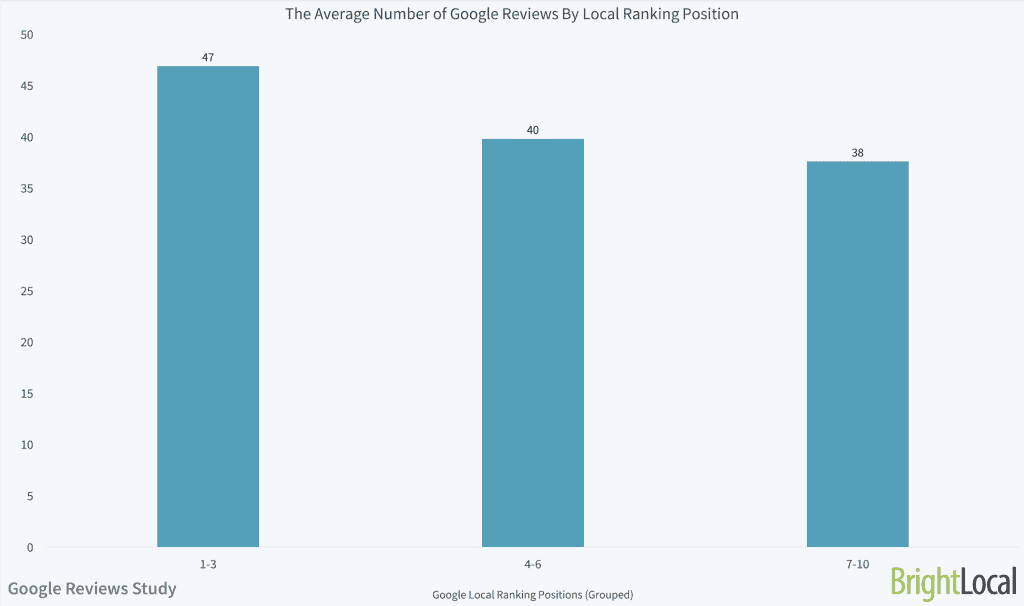
And here is the average amount per industry:

So where do you stack up? Are you dominating your competition already? Are you below your industry average? Or are you yet to get your first review?
Regardless of where you are, it is undeniable that companies with a systematic and scalable review strategy will outperform local competition and achieve long term success.
Here are some interesting numbers:
- 63.6 percent of consumers are likely to check Google reviews of a business before visiting their website — this is more than any other review site (Yelp, Facebook, etc).
- 94 percent of people say an online review has convinced them to avoid a business altogether.
- 90 percent of consumers read 10 or fewer online reviews until they can trust your business.
- Positive customer reviews can increase conversions by 270 percent.
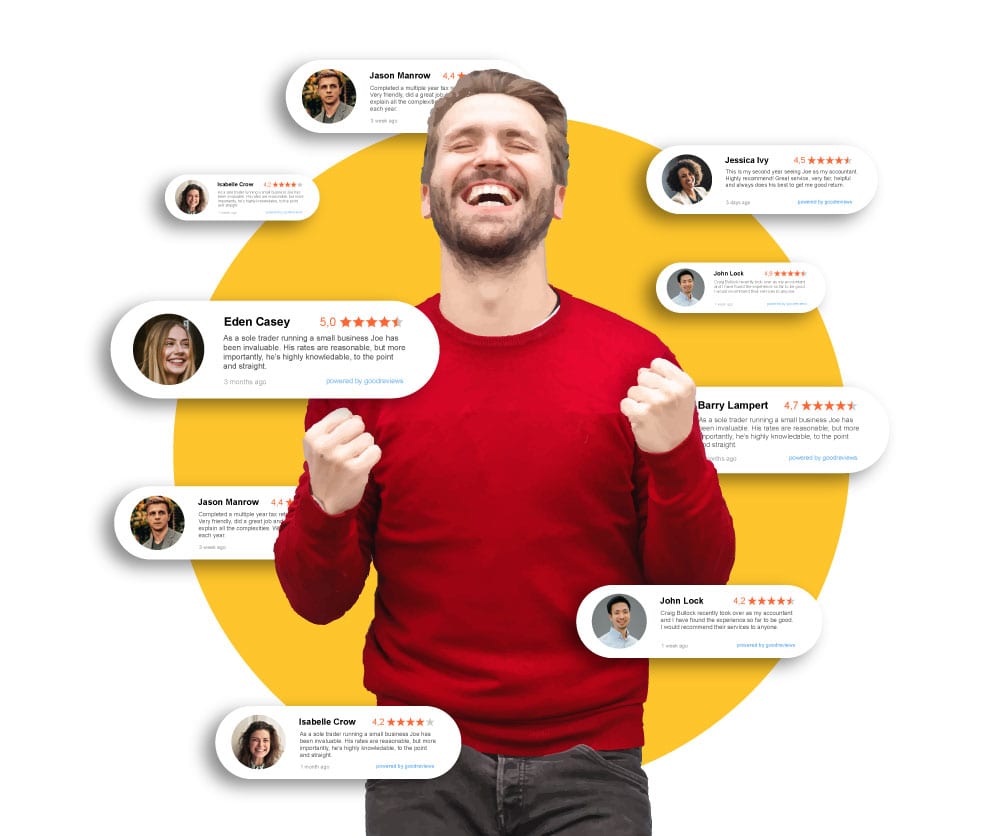
Shameless plug… Using a tool like ours not only will increase your profits immediately but will also let you set and forget your review collection process. Check it out here.
How do you get Google reviews?
The short answer: Just ask.
Don’t beat around the bush when it comes to asking for a review. Sending them a direct email with your request is the best way to feed a response. Techniques that garner better results:
Personalize Your Message
Make your customer feel special – you’re not going to get a review with a boring, desperate email saying, “Review us please!”.
Send in a timely fashion
Catch them early, when your business and products are still fresh in their mind. (Most likely, this is also when they’re the happiest about your product’s capabilities or benefits).
The longer you wait to ask for a review, the less of a chance you have of getting customers to give you one. Don’t take those chances.
Keep It Short
You’re already asking them to take the time to leave a review, so don’t take any more of their time by having them read a novel of an email.
Include a Review Link
As always reduce friction wherever you can. Make it as easy as possible for your customer to leave a review – give them a link!
Want proven templates?
We’ve put together a step by step guide on how to skyrocket your reviews with our proven email templates.
Responding to reviews
More customers expect businesses to respond to their reviews — and quickly.
According to ReviewTrackers’ survey findings, 53.3 percent of customers expect businesses to respond to their online review within 7 days.
In the digital space — just as in traditional feedback channels like post-transaction surveys and support and service phone calls — customers want to be heard individually and addressed personally when something goes wrong.
Review responses make a real and measurable difference — not just to the consumer who leaves the review, but to everyone else who visits the business’s review page. 45 percent of consumers say that they’re more likely to visit a business if it responds to negative reviews.
Take away. ALWAYS respond to reviews.
But how do I respond to negative reviews?
Negative reviews are inevitable.
The sheer depth and breadth of who we serve will never cater for everyone. Also, a business is made up of people and as people, we sometimes fail – that’s ok.
What’s not ok is letting that be the end of it.
How to respond to a negative review (4 Steps)
Step 1: Apologize and sympathize
Acknowledge the customer’s concerns. Even if they are unfounded, show sympathy that they had a bad experience. “I’m sorry to hear about your bad experience.”
Step 2: Insert a little marketing in your response to the bad review
Explain what your customers usually experience. “We’re normally known for our exceptional attention to detail, and we regret that we missed the mark.”
Step 3: Move the conversation offline
Provide contact info with someone at the business so they can discuss the problem in person. “My name is [name] and I am the [Owner / Manager]. I would love to discuss your experience further, please contact me at [phone number/email].”
Step 4: Unhappy to happy
As always, do what you can to turn the situation around. Once you have done so, see if they will remove their negative review. We’ve found wording like this to be successful:
“Many people like you rely on online reviews to make sure they get the best service possible. Having a negative review hurts our businesses’ ability to stand out and provide value. If you feel your experience with us has changed it would mean a lot if you removed or updated your Google review.”
Oh no… someone has left a fake review
Who knows why fake reviews happen. Sometimes they’re written by competitors hoping to one-up you, or even customers who have mistaken your business for someone else’s! What’s important is that you know how to spot and get rid of them in order to keep your online reputation as authentic as possible.
Flagging a review
If you believe you have received a review that is fake, inappropriate or promotes a competitor you can flag it to be reviewed by Google for removal. Only reviews that violate Google policy will be removed.
Follow these steps to flag a review:
- Log into Google My Business.
- Select the location (if you have multiple)
- In the menu, select “Reviews”
- Find the review in question. Click the three-dot menu , then select “Flag as inappropriate.”
It can take several days for someone at Google to review your request and determine whether they will delete your Google review. If possible, ask other people to flag the review also, as this might draw more attention to an offensive review and encourage Google to remove the Google review.
Report to Google Small Business Support
Flagging the review and/or responding to the unfair comments sometimes gets the review removed. But if those strategies fail, the next step is to report the review to Google Small Business Support.
To contact Google’s support for businesses, follow these steps:
- Go to support.google.com/business
- On the top right of your browser, select “contact us”
- Select “customer reviews and photos,” and then “Review removal issues”
- Choose to receive help via phone, web chat, or email
Using any of these methods, you can expect help within 24 hours. If you choose to contact Google via email or chat, it is helpful to have a screenshot of the review in question ready to go.
Google My Business Posts
According to Google, Posts is a feature that allows businesses to publish events, products, and services directly to Google Search and Maps. By creating posts, you can place timely text, video, or photo content in front of customers when they find your business listing on Google. In other words, this is a hyperlocalized communication channel between your business and your local audience (prospects & customers).
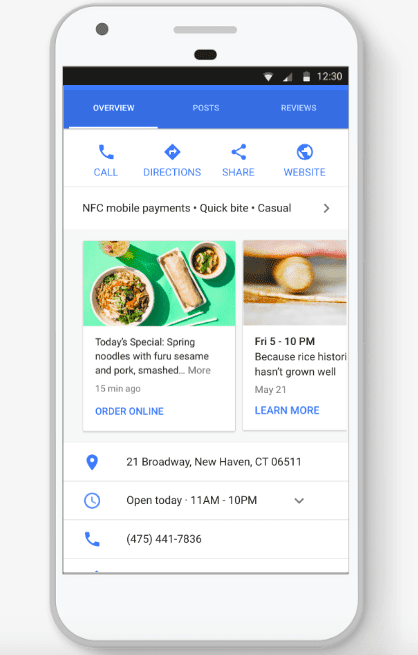
Google openly promote 4 main benefits:
- Facilitate direct communication from you to your local customers
- Improve customer experience with timely information
- Promote your sales, specials, events, news, and offers
- Appeal to your customers with engaging videos and photos
An in-depth study by RioSEO Google Posts improved performance on 4 key metrics:
- Total weekly searches increased by 61.08%
- Total views increased by 47.69%
- Total discovery searches increased by 76.54%
- Total actions increased by 47.49%
Takeaway?
Use Google Posts to increase your reach, visibility, and sales.
Post types
Product posts: Posts that emphasize a specific product your business sells. Product posts require a title and photo or video. You can also include a CTA button and other information. For example, an electronics store may promote a new phone for sale.
Offer posts: Posts that provide promotional sales or offers from your business. Offer posts require a title and start/end dates and times. A “View offer” CTA button is automatically added to the post. You can also include a photo/video, coupon code, link, and terms and conditions with the post. For example, a pizza parlor may advertise a 20% off large pizzas for a week. The offer posts will appear near the top of the Business Profile in Search. They also appear with all other posts in their own tab.
What’s new posts: Posts that provide general information about your business. You can include a photo/video, link, CTA button, and other information. For example, a restaurant could make a post to promote a new menu item. In some countries, Google My Business may also provide automatically suggested posts based on your 4 or 5-star customer reviews. You’ll see these suggestions when you sign in to GMB, or via email notifications.
Event posts: Posts that require a title, start/end dates and time. If no start/end times are entered, then the system will default to 24 hours on the date it’s posted. These posts may also include a photo/video, CTA button, and other information. For example, a bookstore may advertise a local author’s book signing or a book club meeting.
Pro tip: If you are distributing content on other channels(blog, FB, etc) add this to part of that process.
What the faq is Google Q&A and how do I use it
Google Q&A, introduced in August of 2017, is a consumer-facing, crowd-sourced FAQ feature, similar to the Ask the Community feature on Yelp and TripAdvisor, that allows consumers (and businesses) to ask and answer questions about the business from the local Knowledge Panel.
Google’s goal for its local Q&A feature is to provide consumers with enhanced details about a business. In theory, this additional information will allow consumers to find meaningful, timely answers to questions, directly influencing their decision to call or visit the business right from the Knowledge Panel.
BrightLocal put together a deeper study into the dental segment and found:
- 38% asked if the dental practice performed a particular procedure and, if so, how much it costs
- 32% focused on types of insurance accepted
- 7% asked about basic business info, such as email address and fax number
Ok, so now we know more about it.
Well, firstly, as hinted above, anyone on the internet can answer these questions. Would you want one of your customers incorrectly answering a question?
Or as a savvy business owner would you prefer to control the way your business is represented?
The second thing you need to know is that you cannot access Q & A from your business dashboard because this is a bolt-on powered by Maps rather than Google My Business.
However, if you have enabled the Google My Business app on your mobile phone, you will get push notifications when someone posts / asks a question.
To update these / respond to these you have to do it directly from search results.

Click through to the Q & A from search results. All questions and answers will bring up all of them OR ask a question will allow you to post a question – then answer it.

All questions and answers will bring up all of them OR ask a question will allow you to post a question – then answer it. If you do come across an answer that you aren’t happy with you can flag it with Google.
Messaging customers on GMB
That’s right. You can chat back and forth with your potential customers just like on a Facebook.
The rise and use of live chat is undeniable. Today, more than 41% of customers expect live chat to be on your website.
If you have the resourcing use this to steer people into your business and have real conversations. The process is straight forward and has been laid out nicely by Google Support.
Pro tip: If a reception person or junior staff member will be managing this we recommend you empower them by having a script to run off, key questions noted(use the FAQ of your website) and most of all ensure they know who is the main lead handler. Those who come from the GMB channel are ready to buy. Ensure your staff can show them how to do just that.

Short names & URLs

You can add a short name to your profile now as well. Doing so will give you a link to your GMB listing that is more branded.
You can use this to promote your listing and provide customers with an easy link to leave you a review.
You can set your short name listing by going to the Info pane of your GMB dashboard.
We’ll be honest, Google adds and removes features all the time so it can often take a while before we see if a feature is really worth it. In this case, we suggest grabbing a short name as soon as you can. Whether or not we find short names to be an important factor for GMB listings, you’ll want to reserve your short name before someone else does.
Get people to follow you
That’s right. You can follow businesses and people can follow yours.
Most people aren’t using this feature – take advantage.
Google knows that people are looking for ways to save money and find good deals. With this new feature, businesses can reward their customers by giving them welcome offers.
By following your business, they can get first-time deals and always keep in touch to see when new deals are posted.
Not only will this bring you new customers but also repeat customers because people will be notified every time you have new deals.
To set up a welcome offer, open your Google My Business app and tap on your profile. Under “Turn followers into customers,” click on ‘Create Welcome Offer’ and hit ‘Create.’
You can enter the following information in your offer:
- Title (30% off oil changes)
- Description
- Coupon Code (Optional)
- Terms and Conditions (Optional)
- Website (Optional)
Once finished, you can preview your message and publish. For notifications on new followers, and editing or deleting offers, you can read more on Google Support.
Top GMB tools to help you achieve your goals
Google My Business App
Mentioned a few times in this guide GMB App is a no brainer. A free mobile app that helps you manage your business. With the app, you can do the following: Manage how your local business appears on Google Search and Maps. Edit your business information (e.g. address, phone number, and hours).
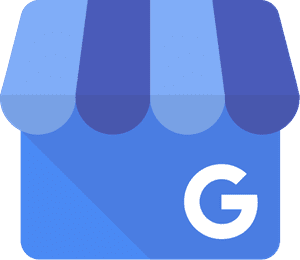

Goodreviews
Few tools can instantly boost your revenue, this is one of them. This product allows you to:
![]() Automated Google Review collection
Automated Google Review collection![]() Request customer reviews in bulk with a few clicks
Request customer reviews in bulk with a few clicks![]() Collect with SMS, your website, email signature & more.
Collect with SMS, your website, email signature & more.![]() Collect reviews in-store
Collect reviews in-store![]() Built-in customer follow ups
Built-in customer follow ups![]() Block negative reviews
Block negative reviews
Google Data Studio
Data Studio is Google’s reporting solution for power users who want to go beyond the data and dashboards of Google Analytics. Using a Data Connector you can get great oversights. Having something like this can help you understand your analytics for multiple locations.
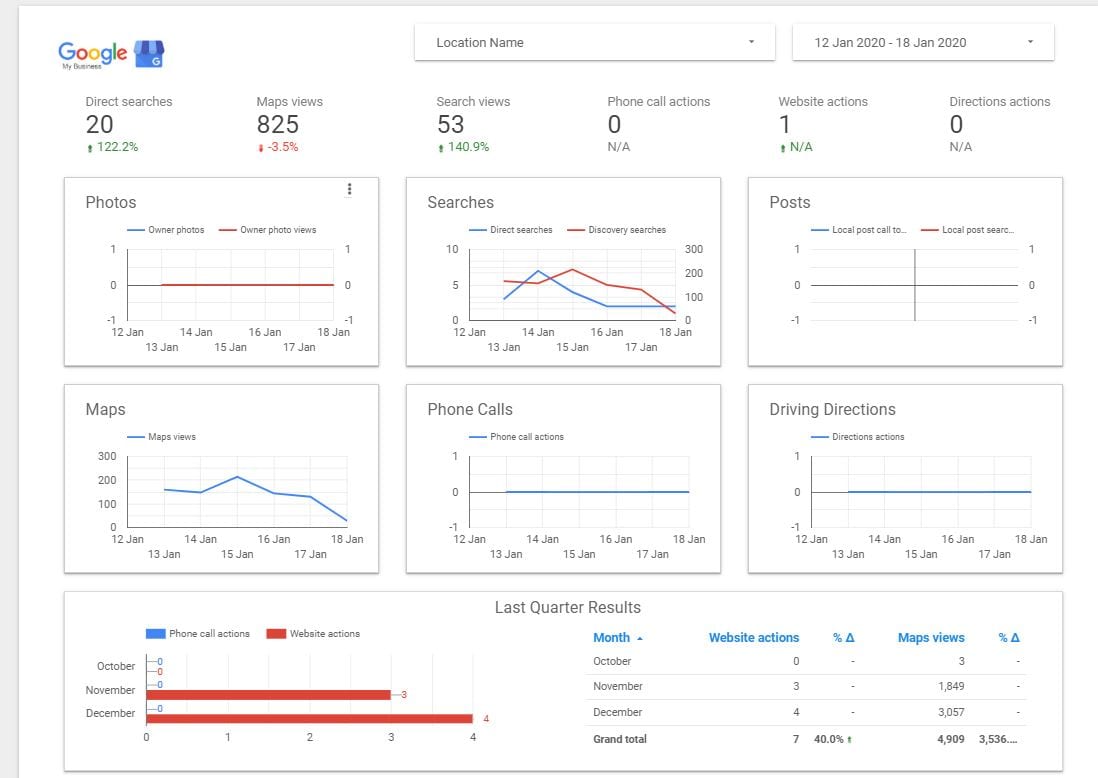

Localviking
Schedule GMB Posts, track where and how you appear and manage all of your Google My Business properties from one easy to use dashboard. Localviking is one of the more popular options within local seo communities as it allows you to get great visual maps of your listing by number.
Bright Local
Whether you’re looking to boost local rankings, increase online visibility, build citations, develop an amazing online reputation or even grow your marketing agency, BrightLocal’s powerful tools can help you succeed. Many use the software daily to identify and analyze ranking functions and check-in on historical ranking patterns.
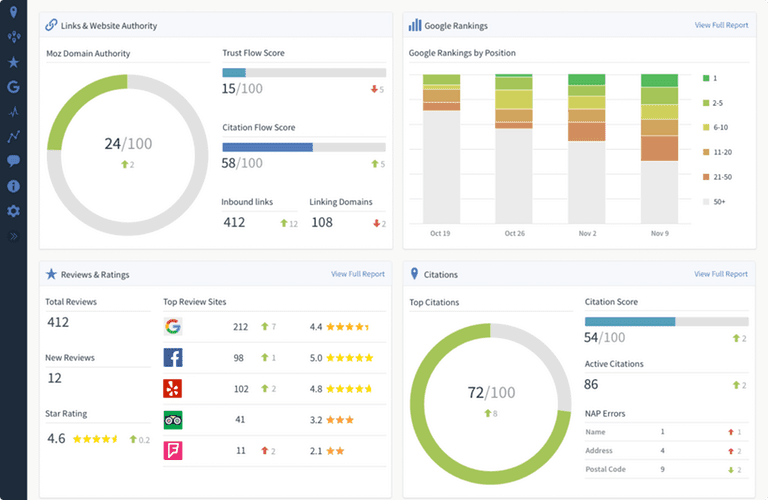
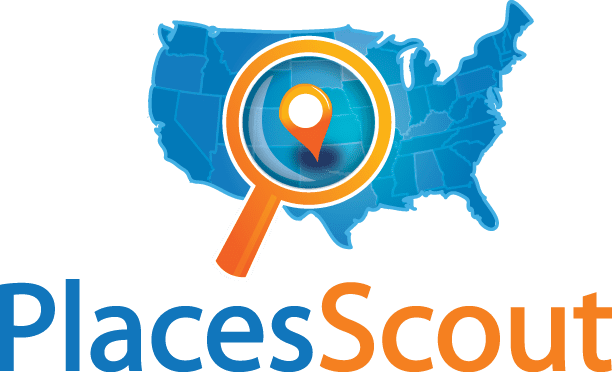
Places Scout
This tool is loaded with useful features and data. They have an incredibly detailed competitor analysis tool and they also have a solid rank tracker that plots rankings on a map across a geographic area so you can see how you rank from multiple searcher locations.
What do others say
Expert advice from around the world
Aaron Agius
Co-Founder & Managing Director of Louder.Online
“In my experience, beating your local competition in SEO in 2020 doesn’t look that different than it did last year – or even a couple of years ago. The primary ranking factors I’m seeing that still have the biggest influence on search visibility include ensuring you’ve built consistent NAP data across multiple properties, building search authority through backlinks from high-value sites, and optimising your landing page and copy for local keywords. I’d much rather see a company focus on nailing these basics than on chasing some new “hack” that promises to be the key to top rankings in 2020, but that doesn’t actually deliver.”
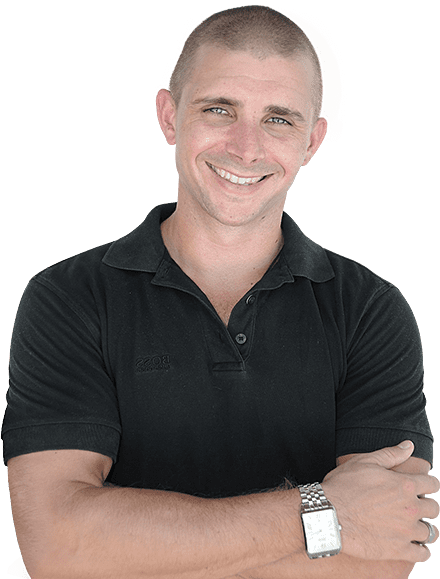
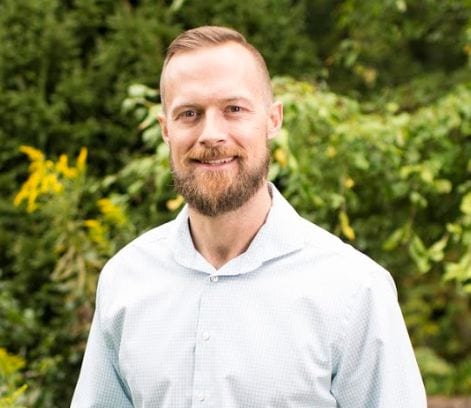
Colan Nielsen
Vice President of Sterling Sky
“My top piece of advice for outperforming your competition in 2020 is to develop a “spam-fighting” strategy as part of your core local SEO to-do list. Learn how to identify, organize and report spammy competitor Google My business listings to Google.”
Shawn Joshi
Founder of Shawnjoshi.com
“As Google releases platforms like Local Services ads, they are empowering businesses who don’t want to rely on external agencies or consultants.
While this is great, it’s going to force businesses to become more educated about their core business metrics.
Those that didn’t pay attention to metrics like customer lifetime value, revenue per lead, or close rates will need to work these into their calculations.
This will allow them to learn how much they can spend to acquire new customers at a profit.”
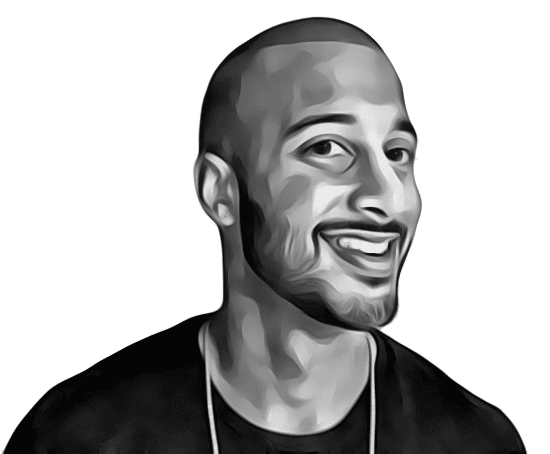
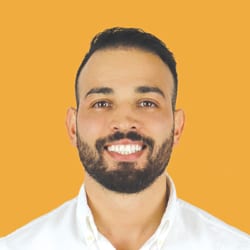
Andrew Raso
Founder & CEO of
Online Marketing Gurus
“The best advice for beating your local competitors? Never underestimate the power of a good review, and on top of that – many reviews. Trust is one of the hardest things to earn, and the easiest to lose. But once you have it (and a wealth of happy reviews to boot) – the return is endless. A GMB with a mountain of reviews adds fuel to your SEO campaign, so build out strategies to grow your profile – whether it’s making it part of your team’s goals or automating emails that go out to your happiest customers.“
Mike Lawson
Co-Founder of TRCREATIVE
I’ll start by analysing the Map reporting feature in LocalViking to see where my client isn’t showing in their geographical area.
I’m quite active with hyper-local relevance, and my two favourite tactics for this are to dial down your service areas in Google My Business, your target town/city has numerous smaller areas – chances are, these smaller areas in the Google database and on top of that, I doubt your competition has been so detailed with their target service area. Win, win.
The second tactic utilises LocalViking’s (again – honestly, I’m not on commission) EXIF editor, by uploading images and posts with images that are geotagged with the different geographical areas that the client is not ranking in.
You’re either a believer or not on the subject geo-tagged images and Google My Business. I’m a believer – yes, they strip the data but I’m sure they still use that data. Controversial, I know.”
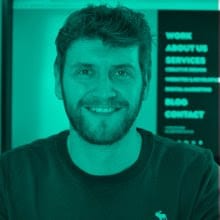

Blake Stockton
Founder of Google Domination
“To outperform your local competition in 2020 upload more photos to your Google My Business listing. Google’s new A.I. (artificial intelligence) can accurately read what’s in the photos you upload to your GMB listing. The A.I. will use your photo info to better understand the products and services your business provides. It will then use this info to more accurately display your business to a potential customer in Google search. Additionally, make sure to upload a diverse set of photos so that Google understands all the products you sell. For example, if you own a restaurant, make sure you’re uploading photos regularly of all types of dishes you serve.”
conclusion
A final note from me
Our time is precious. Our resources are limited.
As any marketing professional worth their salt will confirm, successful marketing is based around a process, where you ‘test, measure, test measure’.
Test everything you do within GMB and then look at the big picture. GMB is only one part of your digital marketing efforts and should be seen as one piece of the puzzle – look at it as such.
Digital marketing strategy is my 10-year obsession. Not search engine optimization (SEO). Not Pay Per Click(PPC). Not social media. Not content marketing. Not even analytics. M-A-R-K-E-T-I-N-G.
If you’d like to chat email me at saul [at] goodreviews.io
Most of all, I hope you got huge value out of this 7000+ word piece and are ready to go and dominate your local competition.

